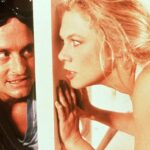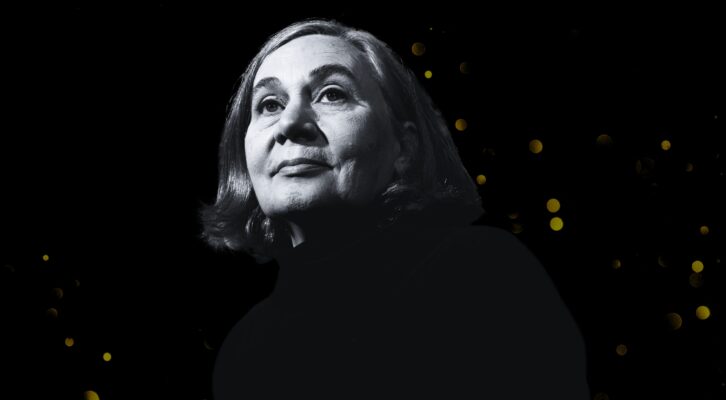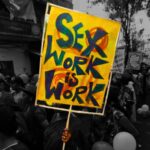Once a place of movie-making fantasy, a decaying movie set became the starting point for vengeance on Hollywood. Known as “Spahn Ranch,” this crumbling and deserted Western soundstage was the ramshackle home and headquarters for what eventually became known as “The Family.” The moniker represented the delinquent and motley crew of outcasts who abandoned their suburban and city lives to follow the scripture according to Charles Manson. There, living away from society and hidden away in the San Bernadino Valley, Manson and his Family came to commit the unthinkable in the summer of 1969.
The carnage started on August 8 when the clan brutally killed pregnant actress Sharon Tate (alongside four others) in a Hollywood home high in the hills. The killers went on a crazed rampage and scrawled the word “PIG” in her blood on the wall before they left. The very next day, the members slaughtered a supermarket executive, Leno LaBianca and his wife Rosemary, writing “death to pigs” in blood again as their calling card.
The murders completely shook the American psyche. Sitting at a complicated juncture of Hollywood and celebrity, a spectacle of death and violence, and a backdrop of uninhibited social mores and “free love,” the crimes unnerved a nation at a time of ever-increasing social emancipation. Joan Didion, writing in her well-known paean to the era “The White Album,” said a “paranoia” was fulfilled by these murders.
The 1960s were indeed now over.
When Mason and the Family were finally apprehended months later, their trial only saw a wild and carnivalesque display staged for an unnerved but fixated public. Manson proclaimed himself a messiah, warning of impending destruction on the social fabric of America. Female members, meanwhile, shaved their skulls and adorned their foreheads with crosses (then later swastikas) in literal and figurative protest to the proceedings they saw as a crime itself.
It was deputy district attorney, Vincent Bugliosi, who was tasked with prosecuting Manson and followers for the gruesome Tate-LaBianca crimes. Since Manson didn’t commit the crimes, it was up to the attorney to build a case that implicated Manson in them and wholly demonstrate his culpability.
These convincing court arguments were memorialized in the 1974 book, Helter Skelter: The True Story of The Manson Murders, which now celebrates its 50th anniversary this month. Taking cues from his own investigation and prosecution of the case, Bugliosi advanced the idea that Manson and his followers committed the murders to instigate a race war between black and white people in America, foretold by the lyrics of the Beatles’ 1968 White Album.
The record ostensibly carried a coded message of an impending apocalyptic conflict—and it needed a spark to start. Bugliosi argued that once this war between the races was over, Manson and the Family believed they would emerge from a bottomless bunker (called “the Pit”) nestled in the Californian desert and soon control the remaining population who survived the bloodshed.
When Helter Skelter was published in January 1974, it became an instant bestseller. (It also enjoys, decades on, the title of most popular true crime book of all time.) Serving as an official judicial and investigative narrative, it sought to authoritatively explain the reasons for the murders that confounded and alarmed so many.
And the volume did so very successfully. The motives went unchallenged for decades.
There was not only the crime’s extremity and abruptness, but also its extraordinary ability to target what many thought were untouchable: celebrities. Bugliosi’s contention, a facsimile to his court arguments, was this: the crimes were committed by Manson’s drug-addled young followers to ignite the prophesized race war—slaughtered elites would be the gasoline to start the blaze.
Such an explanation has indelibly influenced public perception of the the crimes now some five decades since. So much so that it helped perpetuate the mythologizing of Manson, advancing a largely misleading narrative of him as a crazed prophet-like figure and his followers as unhinged and Dionysian-like.
Recent investigative efforts, however, have begun to poke holes in Helter Skelter. Scratch a little and the polish on Bugliosi’s grand narrative of a messiah seeking to start civil conflict—argued successfully at trial—appears less omnipotent and compelling than it once was.
Books such as Tom O’Neill’s Chaos: Charles Manson, the CIA and the Secret History of the Sixties (2019) and Jeff Guinn’s Manson: The Life and Times of Charles Manson (2013), have been thorough and illuminating reckonings on the official Manson murders. Indeed, for O’Neill, it became a twenty-year personal obsession to better understand the motives of the infamous slayings that motivated his own probings.
Bugliosi, as both trial prosecutor and official custodian of the story for the public, troubled O’Neill the most. It’s easy to see why. In his investigation, O’Neill learns that Bugliosi tampered with witnesses during court proceedings and may have covered up evidence. (For the record, O’Neill’s book was published after Bugliosi had died. Bugliosi had threatened to sue O’Neill after he learned of O’Neill’s angle.)
The preamble to Helter Skelter can be troubling when viewed from this contemporary revisionist angle:
For months, Bugliosi collect[ed] and sift[ed] through the grisly evidence, listen[ed] to the chilling testimony of murders and accomplices. Slowly, he put the puzzle pieces together.
Readers are told it was the DA that seemingly uncovered the vast conspiracy that motivated the crimes—not the police. With Bugliosi building one main motive, O’Neill suggests that more benign reasons—just out of sight but nevertheless legitimate—may have been missed, or intentionally left out of the sanctioned script.
One of most compelling explanations unexamined in Helter Skelter was that the Tate murder was a revenge attack gone bad. Manson had previously developed a friendship with Terry Melcher, a successful record producer working in Los Angeles. The allure of a record deal was too tantalizing for the aspiring rock star Manson, who doggedly pursued Melcher to secure a contract, even uses his coterie of young and sexualized girls to entice (and entrap) Melcher into making it so. The deal was never done, with Melcher later trying to rid himself of the sycophantic Manson and weird band of groupies. (Rumor has it that Melcher’s mother, Doris Day, apparently laughed at the suggestion of having Manson signed to the label.)
With Tate now living at the same house that Melcher had previously resided, the frenzied and spontaneous confrontation squared up to vengeance from an aggrieved Manson whose ego had been badly bruised. This is a sentiment echoed by writer Guinn, who says that the house likely represented a rejection from the musical establishment Manson so desperately wanted to access.
Why the carnage and brutality? It may be owed to the chokehold Manson had over these adolescent and twenty-something adults, who had become indoctrinated and enamoured with Manson’s fanaticism. This all bolstered by a heady diet of alcohol and drugs, isolation from mainstream society, and a belief-system that leveraged conspiracy and paranoia of society to unite its members to the “Family.” Anyone surviving the night, career criminal Manson surely told his followers, wasn’t an option.
There is also more damning evidence unearthed by O’Neil. There are interviews with witnesses that were withheld from the defense team and testimony with former detectives who insist that important evidence was destroyed by their superiors during the court proceedings in the early seventies. Does that evidence support the “helter skelter” theory or another motive? We’ll never know.
Elsewhere, conspiracy seems a foot in the crimes, as we learn that Shahrokh Hatami (Tate’s personal photographer) admitted to being notified of the murders over the telephone by a CIA agent—some ninety minutes before the police were even called to the scene. Still, be warned that there are other strange tangents O’Neill pursues, including apparent plans the CIA had to use unwitting hippies in San Francisco to study the effects of LSD, which may have played a role.
Others who have retraced the crimes say there is a grain of truth to the claim that Manson thought there would be an all-out race war one day. James Buddy Day, in Hippie Cult Leader: The Last Words of Charles Manson, argues that after a drug deal had become bloody involving a member of the Family, Manson’s paranoia set in. At the isolated Spahn Ranch, there was a fear that the rebel organization, the Black Panthers, would attack in retaliation. The Tate–LaBianca crimes were therefore part-diversion and part-reprisal.
Manson himself spent a lifetime denying involvement with the Tate–LaBianca murders until his death in 2017. “I didn’t have nothing to do with killing those people. They knew I didn’t have anything to do with it,” Manson told Day before his death. While Manson was never present for these heinous acts, he always had culpability.
A half-century on, no single motive now neatly explains these crimes. Bugliosi, drawing on his far-reaching narrative offered in the courtroom of a fantasy racial conflict, may have offered one exhaustive and comforting explanation in 1974. But now thanks to more discerning investigative efforts—on both Bugliosi’s book and the crimes themselves—the reality of Tate-LaBianca is far murkier than what many were led to believe.
Helter Skelter helped shed remarkable light on crimes that completely upended the American psyche in 1969. But in striving for a uniting and cohesive motive—one incriminating Manson and explaining unexplainable violence—the book likely obscured a mess of contradictory and banal realities lurking just out of sight in America’s most infamous crime.















